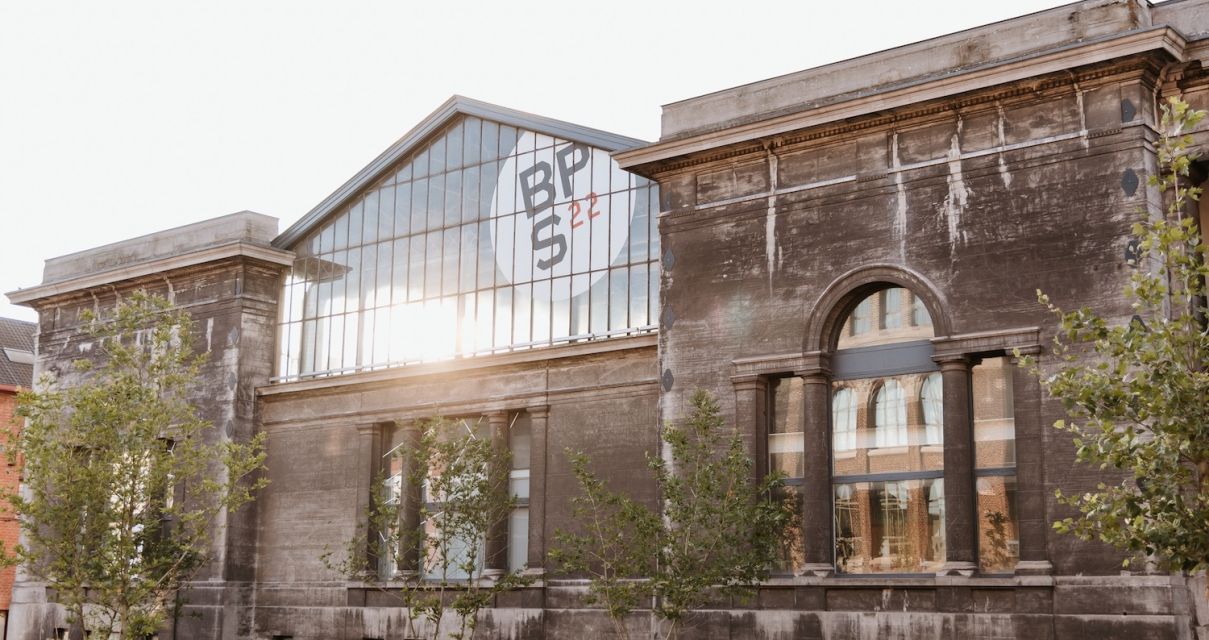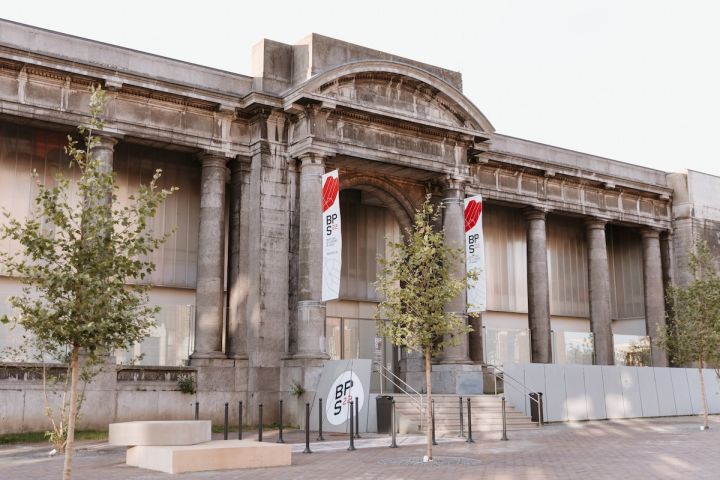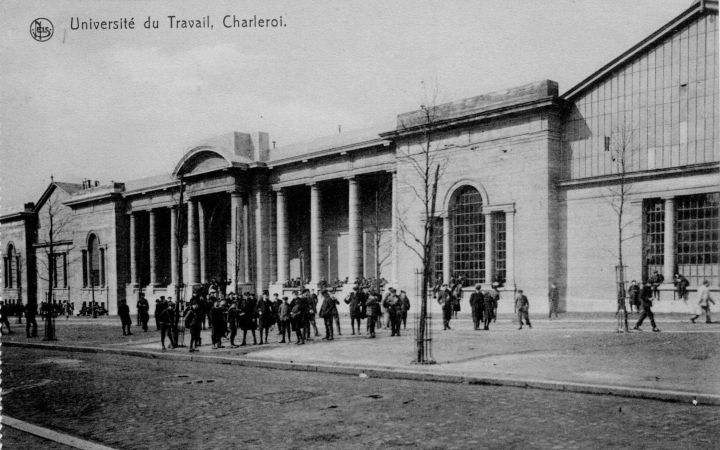About
The focus points
The BPS22 (acronym of Bâtiment Provincial Solvay, n°22 du boulevard Solvay) is the Art Museum of the Hainaut Province. Since its creation, in 2000, firstly as a contemporary creative space and since 2015, as a Museum, the BPS22 has positioned itself as one of the pioneers of the cultural development of Charleroi. The Museum favours art forms centred on current social news and the cultural phenomena characteristic of our times. Temporary, monographic or collective exhibitions are planned throughout the year.
The founding principle of BPS22’s activity is social advancement through accession to culture, which is considered to be a form of “deepening of democracy”. This is an essential vector for democracy which allows citizens to approach the world in which they live in a more critical way.
The focus points of BPS22 are:
to allow the identification of artistic affiliations which go beyond the classifications of traditional art history through a totally new programme;
to decompartmentalise the styles and the times by making works cohabit or have a dialogue, regardless of their technical or historical classification;
to present avant-garde artists and more experimental events that establish links between plastic arts and music, dance, theatre, performance, urban sports, etc.;
to fulfil its critical pedagogical function, both in the planning of exhibitions and in the offers of mediation services put in place (internship, reflection days, conferences etc.)
The BPS22 opened its doors again in 2015, after a thorough renovation. Les Mondes Inversés [The World Turns Upside Down], its big opening exhibition, gathered together a significant collection of contemporary works of art, drawing from popular culture in various ways.
The project
The BPS22, the Hainaut Province's Museum of Art in Charleroi, is an exhibition space especially dedicated to art forms focusing on current social issues. The museum's programme gives prominent space to international artists that deal with greater global issues, such as Kendell Geers, Jota Castro, mounir fatmi and Wang Du, as well as cultural phenomena characteristic of our time, such as the world of media and urban sub-cultures like punk or graffiti, for instance.
The BPS22 notably organised the following exhibitions: the major Marthe Wéry exhibition; The Colours of Monochrome at the Museum of Fine Arts in Tournai for the European Capital of Culture, Lille 2004; and the Brussels South Airport at the Krinzinger Projekte in Vienna. The following exhibitions were organised by and took place at the BPS22 itself: Next Flag. African Contemporary Art; Storage. The Museum Depot; Jota Castro's Universal Exhibition 2; Honoré δ'O's The Quest; a recontextualisation of the Belgian contribution to the Venice Beinnial; Johan Muyle's exhibition (No) More Opium for the Masses; and a solo exhibition of the South African Kendall Geers, Wang Du's exhibition Post-Reality, Jean-Luc Moerman's solo show, Connecting everything in partnership with several big international institutions and Mexico : Esperando/Inesperando, from the collection of the mexican collector couple Isabel and Agustín Coppel.The One Shot! Football and Contemporary Art exhibition, designed at the BPS22, was displayed in Mube, Sao Paulo during the Brazilian World Cup in 2014, while Europunk! Punk Visual Art in Europe was shown in Charleroi after Rome and Geneva, but before the City of Music in Paris. T-Tris, the joint exhibition of the Hainaut Province art collection (6000 works stored at the BPS22), the Muhka (Museum of Contemporary Art Antwerp) and the Mudam (the Grand Duke Jean Museum of Modern Art, Luxembourg) were also a noteworthy project in the BPS22 programme.
In the space of a few years, the BPS22 team formed national and international collaborations and partnerships with institutions that are widely recognised. In Belgium, these institutions include: the Photography Museum in Charleroi and Charleroi/Dance; the S.M.A.K, Ghent; and the Blac, Matrix Art Project, Brussels. Internationally, the BPS22 has worked with the following institutions, among others: the Palais de Tokyo, Paris; the Criée Centre of Contemporary Art, Rennes; the Migros Museum, Zurich; the FRAC-PACA (Regional Contemporary Art Fund), Marseille; the FRAC-Alsace, Selestat; the Baltic Art Centre, Gateshead; the MAC, Lyon; the Mudam, Luxembourg; the French Academy - Villa Medicis, Rome; and the Mamco, Geneva.

The place
The BPS22 is located in an old industrial hall of nearly 2500m2, within the premises of the Paul Pastur University of Work. A 1911 industrial edifice made with glass and iron, it was erected during the Commercial and Industrial Exhibition in Charleroi for the Fine Arts Pavilion. Once the event finished, these buildings became the premises of the new University of Work which had two objections: to ensure the education of citizens and to provide industries with every type of worker needed, from industrial workers to technical engineers and chemists. The university site is an illustration of the pre-emptive policy of social elevation which developed in Belgium in the early 20th century.
Designed by the architect Gabriel Devreux, the Workshops (previously called the Solvay Provincial Building, abbreviated as BPS22 in French) are an architectural whole whose impact is created by historical references, such as the neoclassical concrete colonnade, the symbol of a political power perpetuating an ancient social hierarchy. The central row of columns is topped by a curved pediment and flanked by Palladian windows on both sides. The principle innovation, at the time, was the glass panels constituting the two great halls linked by the columns. These new materials, glass and iron, were a reference to the industrial wealth of the region. They were used for their technical qualities, their symbolic significance and also for the general aesthetic appearance of the building.
The halls are configured like a classic basilica, with a central nave flanked by two colonnades. This referential architecture is evidence of the 'removal of holiness' suggested by social art in the Walloon region at the end of the 19th century and in the early 20th century: from the church to the factory, with its procession of new martyrs, secular pietàs, and so on. During the Commercial and Industrial Exhibition in 1911, the halls housed the Fine Arts Pavilion. This was an exhibition of Walloon art organised by the Minister Jules Destrée, according to his autonomist political manifesto which began with, 'Sir, there are no more Belgians'. Considering the surface area of each wing, approximately 1000 m2, it is likely that that the structure of the exhibition space was used for large canvases, which was frequent at the time, on which paintings were hung.
These buildings, now partially listed by the Walloon region, were then filled with workshops for industrial learning, such as clothes manufacture, masonry or welding. The walls still bear the scars of these subsequent activities. Rebaptised BPS22, the building became a museum in 2000, recognised as much on a local level as a national or international level.
Since January 2014, extension work is transforming the BPS22 into the Hainaut Province's art museum. Following competitive bidding, the work on this ancient industrial hall was entrusted to the architectural firm Archiscénographie Roland, who had already carried out renovations at the Félicien Rops Museum in Namur, and the Abattoirs in Mons (in collaboration with Matador).
For the BPS22, the project plans to transform one wing, the Pierre Dupont room, into an immense 'white box' of 800m², strictly respecting museum standards. The Great Hall, the 'crude' industrial building of 1200m², will be preserved, as is particularly adapted to forms of experimental contemporary art and it is a part of the identity of the BPS22. In these two great distinct spaces, two experiences are proposed: the first being contextual and linked to the history of the site and the building, the second, aseptic, atemporal and atopic, in accordance with the modernist tradition since 1960s.
In addition, the diversification of the spaces was also given importance. Several small rooms, including the Grenier, Mirador and Project Rooms, have been created, meaning that the BPS22 can now show art projects in smaller formats, as well as 'quirky' experiences or more intimite works. A set has also been created for performances or individual concerts. Lastly, artists will be able work in the new studio to develop their productions in situ.
Welcoming the public was given special attention. Apart from the entrance area which has been completely restructured to encourage circulation in the exhibition rooms, one of the seminal areas of the BPS22, mediation, was emphasised by the creation of two rooms for learning activity, the Workshop and the Lab. A third room, the Local room, has been dedicated to activities carried out with local inhabitants.





